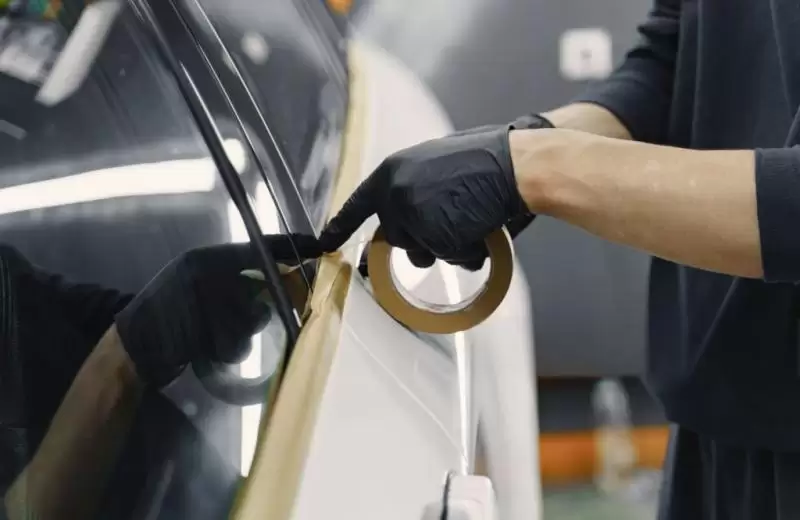
If you're working on a car project, this question has probably crossed your mind. Whether you're painting in humid conditions, dealing with morning dew, or need to wash the vehicle between coating stages, understanding how auto masking tape handles moisture is crucial for professional results.
The Short Answer
Most standard auto masking tape is not designed to get wet. Water can compromise the adhesive, causing the tape to lift, bleed, or leave difficult residue. However, specific types of professional-grade masking tapes offer water resistance for particular applications.
What Happens When Automotive Tape Gets Wet?
When moisture meets regular masking tape, several problems can occur:
1.Adhesive Failure
Water breaks down the adhesive bond. The tape edges lift, allowing paint to seep underneath. This creates fuzzy lines and ruins your clean paint job.
2.Paper Tape Breakdown
Traditional auto masking tape with paper backing absorbs water like a sponge. The tape becomes soggy, tears easily, and may even disintegrate.
3.Residue Problems
Wet tape often leaves behind sticky glue that's difficult to remove. This residue requires additional cleaning and can damage the paint surface.
When You NEED Water-Resistant Tape
Some automotive scenarios demand moisture-resistant tape:
• Outdoor Painting: Unexpected rain or morning dew
• High-Humidity Environments: Humid climates or poorly ventilated garages
• Wet Sanding: When you need to sand between coats without removing tape
• Vehicle Washing: Preparing surfaces that need cleaning before painting
Choosing the Right Tape for Damp Conditions
For projects where moisture is a concern, look for these features:
1.Vinyl or Plastic Backing
Unlike paper tapes, vinyl-backed auto masking tape repels water effectively. The non-porous material prevents moisture absorption, maintaining the tape's strength and adhesion.
2.Water-Resistant Adhesive
Specialized adhesives maintain their grip even when exposed to moisture. These are typically rubber-based formulations designed for automotive environments.
3.Proper Temperature Rating
Ensure the tape can handle your working temperatures. Quality auto masking tape should perform consistently in your specific climate conditions.
The QKD Standard: 15+ Years of Automotive Solutions
At QKD, our experience spanning over 15 years has taught us that automotive environments are unpredictable. That's why we've developed auto masking tape solutions that account for real-world variables like moisture, temperature changes, and chemical exposure.
Our water-resistant auto masking tape features:
• Vinyl backing that repels moisture
• Consistent adhesive that maintains grip in humid conditions
• Clean removal without residue, even after light moisture exposure
• UV resistance for outdoor applications
Best Practices for Moisture-Prone Projects
1.Surface Preparation is Key
Ensure surfaces are completely dry before applying any tape. Moisture trapped under the tape will guarantee failure.
2.Choose the Right Tape
For projects where moisture is inevitable, invest in water-resistant auto masking tape. The extra cost is minimal compared to redoing a paint job.
3.Application Technique Matters
Press firmly along all edges to create a solid seal. This helps prevent moisture from creeping underneath.
4.Monitor Weather Conditions
Check humidity forecasts and plan your work accordingly. Even the best tape has limits.
5.Remove Tape Promptly
Don't leave tape on longer than necessary, especially in damp conditions.
When to Avoid Moisture Entirely
Despite available water-resistant options, some applications should always stay dry:
• Fine Line Work: Precision edges require optimal conditions
• Delicate Surfaces: Fresh paint or custom finishes need maximum protection
• Long-Term Masking: Projects lasting more than 24 hours
The Bottom Line
While you can find auto masking tape that handles moisture reasonably well, the golden rule remains: keep your tape as dry as possible for best results. Water-resistant doesn't mean waterproof, and pushing the limits usually leads to compromised quality.
At QKD, we believe in setting realistic expectations. Our 15+ years in the automotive industry have shown that proper preparation and choosing the right materials make all the difference between an amateur attempt and a professional finish.
FAQ: Your Auto Masking Tape Questions Answered
Q1: How long can automotive masking tape resist water exposure?
Even water-resistant auto masking tape has limits. Most quality tapes can handle light moisture for 2-4 hours, but prolonged exposure will compromise adhesion. For best results, minimize water contact whenever possible.
Q2: Can I use regular household masking tape for automotive projects?
No. Household masking tape lacks the temperature resistance and adhesive quality needed for automotive applications. It will likely fail when exposed to paint solvents or temperature changes.
Q3: What makes QKD's auto masking tape different from competitors?
With over 15 years of experience, QKD has engineered our auto masking tape to handle real-world shop conditions. Our tapes feature enhanced adhesive systems that maintain grip in varying humidity levels and temperature ranges that commonly occur in automotive environments.
Q4: How should I store masking tape to maintain its water resistance?
Keep auto masking tape in its original packaging in a cool, dry place. Avoid temperature extremes and direct sunlight, which can degrade both the backing material and adhesive over time.
Q5: Can I remove and reuse automotive masking tape?
No. Once applied and removed, the adhesive properties are compromised. Reusing tape will result in poor adhesion and potential paint bleed-through.
